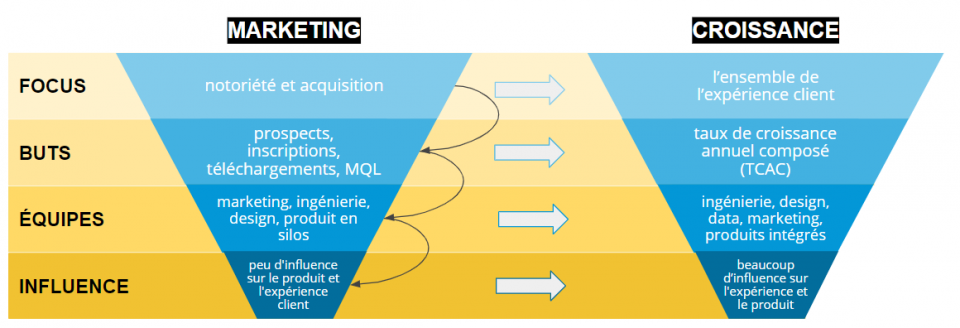Contributor
How to Become a Growth Champion
Contributor
What distinguishes a marketing expert from a growth champion? In a not-so-distant past, marketing leaders were all about brand management, creativity and promotional expertise. But today, the mark of a real champion is their ability to grow a business.
In a time of limitless opportunity and limited resources, the only marketing measure that counts is growth. Stimulating growth means rethinking the traditional definition of marketing to include activities that many companies still don’t think of as marketing.
An omnipresent technology that contributes to redefining growth
“Think of digital transformation less as a technology project to be finished than as a state of perpetual agility, always ready to evolve for whatever customers want next, and you’ll be pointed down the right path.”
Amit Zavery, VP and Head of Platform, Google Cloud
Customer behaviour, wants and needs are evolving faster than ever. It’s no longer possible to make far-reaching business decisions without being in sync with these changes.
The integration of technology into every area of a business has brought about a fundamental transformation in how companies act and create value for their customers. This digitization isn’t just about automation and better analyses of existing data, it’s about changing the way we think, and it requires us to adopt new ways of solving problems.
The mobile experience is an excellent example of how things have changed. By giving people immediate access to information, smartphones are putting power in the hands of the customer, whether it’s to do a cost comparison, check the availability of a product at a local store or learn how to change a tire on YouTube. The constant search for immediate answers is creating a new relationship with brands: a customer journey made up of disparate experiences, that need to be made both coherent and positive.
While technology might seem to complexify the relationship between the brand and the customer, the flipside is that it offers brands opportunities to control how customers’ experiences play out.
A new era requires new strategies
“We’ve moved from digital products and infrastructure to digital distribution and Web strategy to now into more holistic transformations that clearly are based on mobile, social media, digitization and the power of analytics and we think it’s really a new era requiring new strategies.”
Saul Berman, VP and the Chief Strategist for Digital Strategy & IX, IBM Global Business Services
With digitization, we are seeing a rise in trends like:
- B2B e-commerce
- Industry 4.0, IoT
- Machine learning
- Platform automation
- Data connectivity
The accelerated quest for new technology too often overshadows the fact that a company’s primary mission is to target the right person, with the right product and the right message, at the right time. I would also add that it should be in the right format and on the right channel in order to create coherent, memorable and enriching experiences, both for the user and the brand.
“When digital transformation is done right, it’s like a caterpillar turning into a butterfly, but when done wrong, all you have is a really fast caterpillar.”
George Westerman, scientific researcher, MIT Sloan Initiative on the Digital Economy
A typical digital transformation effort relies on a complex use of technology to increase a company’s speed and ability to learn. Some traditional companies are accustomed to being innovative when it comes to product development. Few, though, are capable of rapidly deploying digital technology to respond to the real needs of customers, resolve operational problems or optimize the organization’s performance.
Most management teams understand the opportunity technology presents, but under-estimate the investment required to update the parts of their business models that are ripe for change. Too often, they focus their digital investment on tactics, “Should we work on customer engagement or the supply chain?” But forget to answer the fundamental questions that foster strategic vision:
- What are the real, concrete needs of our customers?
- How can we choose the right initiatives?
- What’s an appropriate level of investment for each initiative?
- How can we test our hypotheses and scale them up to generate the greatest impact?
- Have suppliers, distributors and customers become more demanding in terms of technology and the management of information and data? What impact will that have on our activities?
The active pursuit of growth definitely creates a buzz around tech solutions, but from all evidence, the thing that brings about the greatest transformation isn’t technology.
Two solitudes: marketing expertise and digital technology expertise
A rift has opened in recent years between marketing expertise and digital technology expertise, caused mainly by traditional organizational structures that are poorly adapted to this new era. Successful marketing is no longer limited to awareness and customer acquisition. Real growth through marketing rests on the customer experience as a whole. This holistic perspective, made up of different skill sets, makes it easier to promote ideas and learning through experimentation by crossing the boundaries that traditionally existed between roles.
Take the case of an SaaS company earning $100,000 in recurring monthly revenue and with a monthly unsubscribe rate of 6%. The company would need to increase its monthly acquisition revenue to $227,500 in order to achieve annual growth of 100%. However, if it could drop its unsubscribe rate to 3%, it would only need to earn $167,000 in monthly acquisition revenue to achieve the same growth. This tells us that building a long-term relationship with the right customers can lower costs associated with acquisition activities and rapidly create economic value for the company.
If finance is responsible for the flow of funds coming in and out of a company, growth is owned by the flow of customers coming and going from a brand.
Growth begins with an in-depth understanding of the value of the brand’s offering and consists of moving new users towards a positive experience as quickly as possible. Moreover, a focus on growth effectively tears down silos within an organization by creating a common language and facilitating a vision, ambitions and actions that act on the entire path of the customer experience.

Though they vary from one company to another, there are some elements that are fundamental to a successful growth strategy:
- Focus on value: The use of qualitative research and quantitative data analysis to gather in-depth information on user behaviour throughout the customer journey.
- A tone of co-creation: The creation of a cross-functional team or collaboration that transcends the traditional silos of marketing, sales, IT and product development.
- The quality of multidisciplinary interventions: A clear definition of each team’s responsibilities when it comes to the results that stem from the customer journey, and of who is responsible for the performance of the tools used across the journey.
- A culture of data-led learning: The development and rapid testing of new ideas, followed by rigorous analysis and the transparent communication of data to allow the entire organization to take action based on the results.
In other words, when you put the focus on value, you can develop a culture that strongly integrates testing and the use of data in decision-making at each stage of the customer journey. When you put a focus on growth, you force the entire company to work together in close collaboration to get better information. It therefore follows that any role or responsibility focused on growth absolutely needs to concentrate on the entire customer journey to find innovative ways to stimulate user acquisition, encourage customer loyalty and transform customers into brand ambassadors.
So, who’s really responsible for growth?
“In today’s era of volatility, there is no other way but to re-invent. The only sustainable advantage you can have over others is agility, that’s it. Because nothing else is sustainable, everything else you create, somebody else will replicate.”
Jeff Bezos, President and CEO, Amazon
In terms of responsibility, authority, capacity and organizational links, growth champions differ significantly between one company and another. However, the companies that show the greatest revenue growth and the highest profitability have one thing in common. They prioritize the creation of roles that “own” the main functions supporting the company’s growth, whether or not they adhere to conventional definitions of marketing, sales, IT or product practices.
Companies like Coca-Cola eliminated the position of CMO and grouped marketing, innovation and strategic growth together into a single function within the company. This followed in the footsteps of Pepsi, Intel, IBM, Samsung and others that had explicitly linked marketing with the growth imperative, and had done so for nearly fifteen years.
These new models of growth champions assume strategic responsibilities in addition to — not instead of — traditional marketing mandates and they excel at management in general. They lead strategic growth initiatives, a task that often, in other companies, is supervised by finance or sales.
Achieving growth through digital transformation: a team initiative
“Digital transformation requires changes to processes and thinking—changes that span your internal organizational silos.”
George Westerman, MIT
Ideas for initiatives to create growth can originate in practically every area of an organization. It’s individuals’ capacity for analysis and leadership that makes this cross-functional work possible, and facilitates the implementation of a framework to prioritize and organize the pace of growth-specific improvements and innovations. Cross-functional work is necessary to develop and execute growth initiatives.
Technology solutions represent only a small part of the total cost of a digital transformation. Organizations that complete successful transformations plan their investments around the development of their human capital. In this way, they are able to prepare the organization to manage change and fill any internal gaps, particularly in terms of culture and the management of business processes related to technology, which often stand in the way of an adoption of digital.
What if you were already a growth champion?
The leaders who use digital technology and innovation to stand out from the competition are the ones who are ready to commit to real change in how they work, how well they know their customers and how they mobilize their teams to advance better ideas. They share characteristics like:
- Vision and resiliency: A leader who is ready to question the status quo, internally and externally, who encourages their team to go above and beyond their goals, and who aligns the ambitions of the organization with the needs of customers.
- Clear ambitions: A leader who ensures that the goals of the organization are reflected in its everyday operational activities and that these goals continue to be tangible thanks to clear objectives and credible guiding principles.
- Sharing aspirations and values: Strong leadership and common ambitions and values are essential for inspiring exceptional performance within a team, and forming deep, cross-functional relationships.
- Innovation in the DNA: This translates to what you do and how you do it. Ancred in the ambitions of the organization, innovation is sustained by the creativity and autonomous action of the individuals that make up each team.
- Investments aligned with ambitions: The high return on innovation rests as much on the results of the innovation as on well-targeted investments where it matters most.
In short, it’s time to recognize that the status quo is not a viable option. The time has come to move up the learning curve to become a digital leader — a growth champion.

.jpg)
.png)




